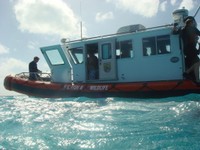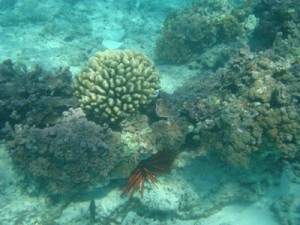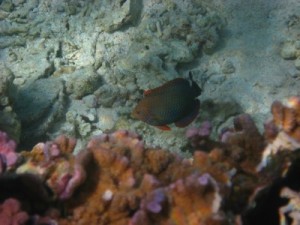As we snorkeled on the north side of Midway atoll, we saw a huge difference in the amount of coral and the size of the fish compared to what we observed on our previous snorkeling experience in Hanauma Bay. This raised questions for us about how to let people appreciate a site and still preserve it.
Another great day on the atoll. Like nearly all great days, ours began with biscuits and sausage gravy. In the morning Dave Johnston gave an excellent lecture on the oceanography of the North Pacific. This led to several interesting discussions on predicting primary productivity, marine mammal management, persistent plastics, and a number of other relevant alliterations.

In the afternoon, the beautiful weather allowed us to take our first snorkel trip here at Midway. After lunch we climbed aboard our boat and set out for the north side of the atoll. When we reached a spot called Reef Hotel, we put on our wetsuits and jumped in the water.
The coral was amazing. I was immediately struck by the amount of living coral compared to Hanauma Bay, where we went snorkeling last week inOahu. Midway is a far less hospitable environment for corals than Hanauma Bay because of its latitude. However, the hundreds of thousands of tourists that visit Hanauma Bay each year have diminished the coral there, while many parts of Midway Atoll have seen very little human pressure. (There also are many places in the atoll where there has been heavy human impact, from dredging and military activity.)

The number of fish at Hanauma Bay was comparable to the number of fish we saw today, but the fish here at Midway were far larger. Brilliantly colored parrot fish, nearly two feet long, regularly swam by us, and a number of giant trevally, more than four feet long, would swim within a few meters of us. We also saw many species of wrasses, butterfly fish, angelfish, and goatfish.

While most of this class has been focused on whales, seals, albatrosses, dolphins, and sea turtles, this snorkeling trip allowed us to finally see some charismatic organisms. I’m speaking, of course, about echinoderms. The reef was crawling with amazing echinoderms. There were absurdly large sea urchins—nearly two feet across—nestled themselves at the base of coral heads; keeled heart urchins burrowed in the sand; and enormous black sea cucumbers lay on the sand between coral structures.

When the wind and waves started strengthening in the late afternoon we called it a day, and went back to the island. Our experience snorkeling here and in Oahu raises some interesting questions about how to let people experience and appreciate a resource while still conserving it. Can snorkeling be done in such a way that it does not hurt the coral? Should we set aside certain areas as “sacrificial” plot in order to preserve other areas? These questions can be expanded to the entire national monument. Right now, it is extremely difficult for anyone to enter the monument, but if you want to maintain support for the monument, people have to be able to experience it. Will Midway become the sacrificial plot of the National Monument?

Great post and great questions– how do we balance a growing, resource demanding human population AND maintain (and improve the condition of) our natural resources? I believe marine reserves have an essential role. Restoration may be another key. Could we maintain some coral reef areas for human enjoyment by periodically restoring them, throuch closed seasons and introducing laboratory-propagated corals? It’s a thought.
I have been moved deeply reading all of your entries and have enjoyed every moment of my “armchair/computer chair” traveler experience. Thank you for sharing.
Yes, the environment is in deep trouble. Listening to your voices-the passion and commitment, I feel hope. Thank you and the best of luck to each of you as you venture out to solve these problems. Anne
You asked “Can snorkeling be done in such a way that it does not hurt the coral? Should we set aside certain areas as “sacrificial” plot in order to preserve other areas?”
That is an interesting idea. I would not like to see damage done to the coral the way you describe it in Hanauma Bay. Yet I marvel at the incredible photographs I see taken in the more mature/live coral areas. So I would say stay out of the Midway Atoll and let the Hanauma Bay serve as the lesson to us. Let only limited researchers and professional underwater photographers access at prescibed intervals.
Thanks for increasing our learning.